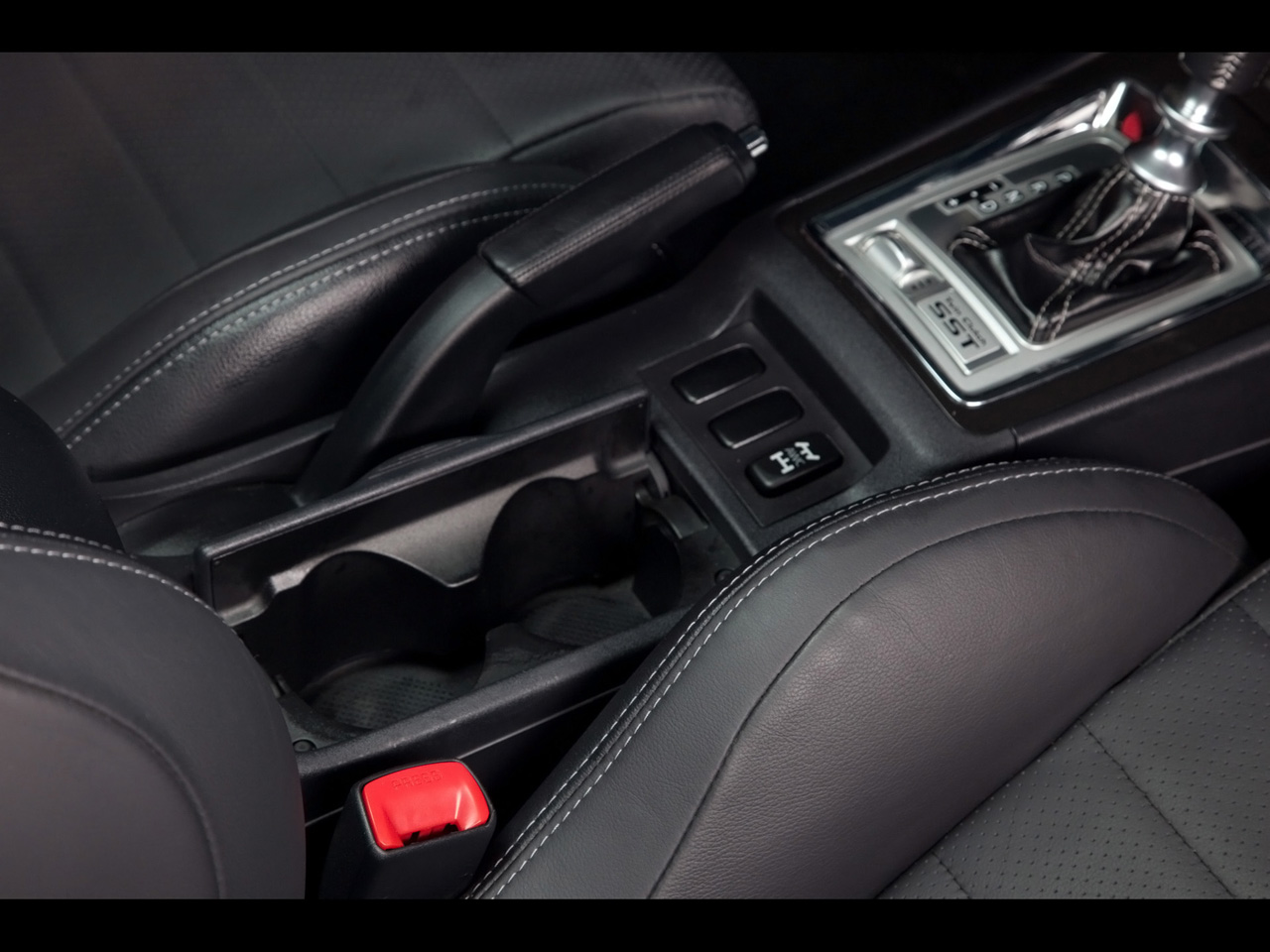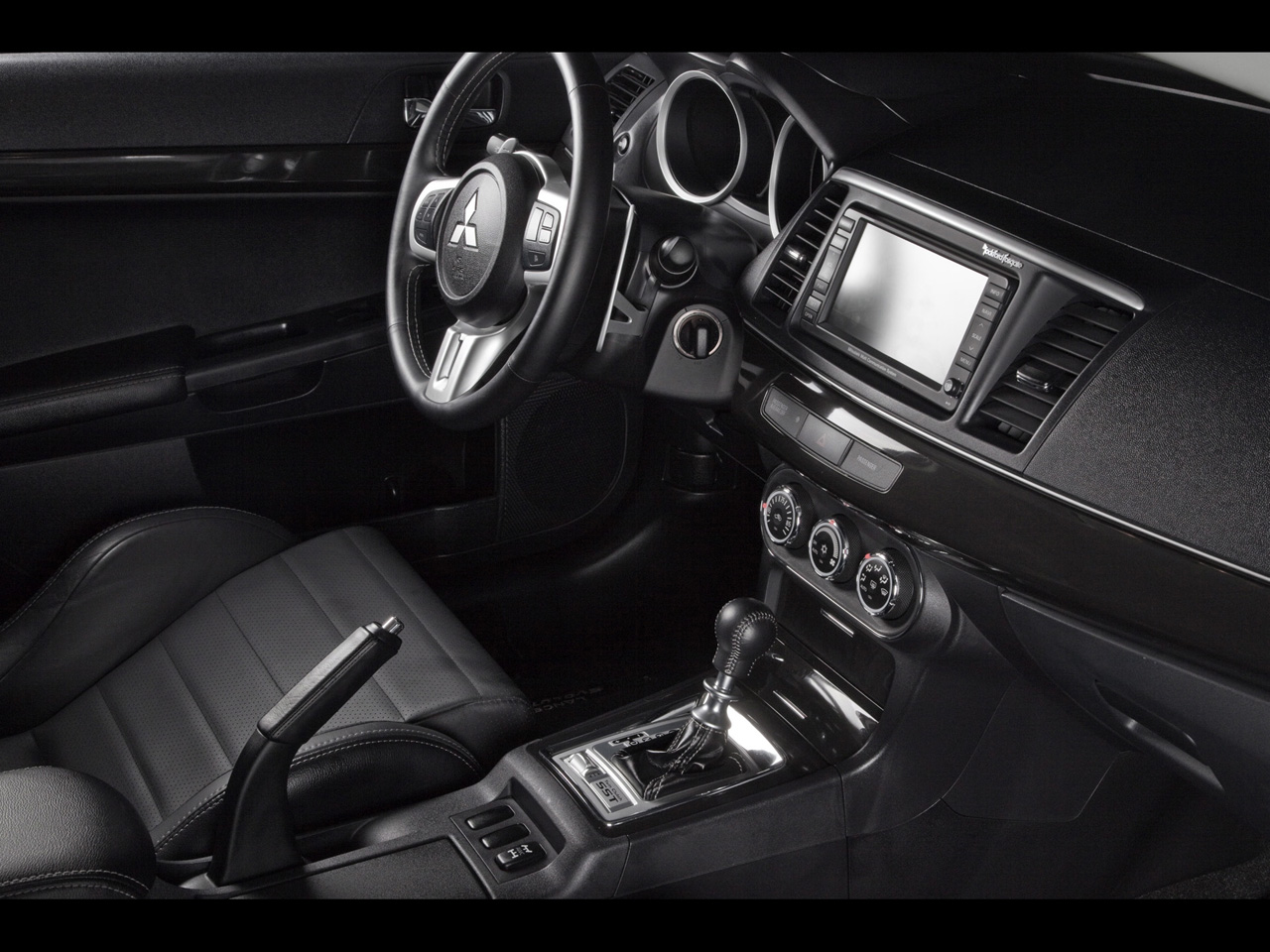2010 Mitsubishi Lancer Evolution MR Touring
|
Price |
-- |
Production |
-- | ||
|
Engine |
2 liter inline-4 |
Weight |
-- | ||
|
Aspiration |
turbocharged |
Torque |
300 lb-ft @ 4000 rpm | ||
|
HP |
291 hp @ 6500 rpm |
HP/Weight |
-- | ||
|
HP/Liter |
145.5 hp per liter |
1/4 mile |
-- | ||
|
0-62 mph |
-- |
Top Speed |
-- |
(from Mitsubishi Press Release) 2010 Lancer Evolution Offers Greater Everyday Refinement With Turbo/Intercooled Engine, Super-All Wheel Control, And New Upscale MR Touring Model
While remaining true to
the core values that have made the Lancer Evolution synonymous with
thrilling performance, the next-generation 2010 model offers new
premium features and user technology options for a more refined
everyday driving experience.
The boldly styled 2010 Lancer Evolution showcases the latest
performance and handling technology, including an all-aluminum
291-hp 2.0-liter turbocharged/intercooled engine and the Super-All
Wheel Control (S-AWC) dynamic handling system. S-AWC offers an
extraordinary level of grip and control at each wheel, going well
beyond the capabilities of other all-wheel drive systems.
Three different Lancer Evolution models will be offered in the U.S.
market for 2010: the GSR with a 5-speed manual transmission and the
Lancer Evolution MR and MR Touring, both with a 6-speed Twin-Clutch
Sportronic Shift Transmission (TC-SST), a new-generation automated
manual transmission. The MR model is equipped exclusively with
Bilstein shock absorbers and Eibach springs, two-piece front brake
rotors for better heat dissipation, BBS forged-alloy wheels, HID
headlamps and additional interior features. The MR Touring model
adds to the MR's impressive list of features with such premium
options as a power glass sunroof, leather seating surfaces with
heated front seats, rear lip spoiler, automatic on/off headlamps,
insulated front windshield glass, and improved sound insulation. The
GSR is now also available in Rotor Glow Orange.
Design Evolution
The 2010 Lancer
Evolution design makes a maximum performance statement, blending
concept car themes and sound aerodynamic principles while conveying
the brand's rally heritage. A shark-nosed front end inspired by jet
fighter air intakes, a distinct wedge-like profile and crisp, taut
lines highlight the basic design. New for 2010 are updated larger
side air dams, tail lamps with black extensions and a short pole
200mm antenna. The new Lancer Evolution looks the part of a
street-wise sports machine with its unique front end, aggressively
sloping hood with integral air scoop and engine heat outlets, boxed
fenders and 18-inch wheels.
Inside, the Lancer Evolution presents a "class up" approach and
shows a new international flair. Available user technology,
including high-end Rockford Fosgate® audio and navigation systems,
reflects the tastes of a broadening customer base.
2.0-Liter Turbocharged Engine
A 2.0-liter intercooled
and turbocharged DOHC inline 4-cylinder engine, based on a
reinforced cast-aluminum cylinder block, powers the 2010 Lancer
Evolution. The 4B11 T/C engine employs a direct-acting valvetrain
for reduced weight and MIVEC variable valve timing is used on both
the intake and exhaust camshafts. The rear-located (firewall side)
stainless steel exhaust manifold helps improve weight distribution
and the free-breathing exhaust system features a large-volume main
muffler with dual tailpipe outlets.
Keeping with the Lancer Evolution's sporty background, the 4B11
produces a healthy 291 hp at 6,500 rpm and 300 lb.-ft. of peak
torque at 4,400 rpm. Even with these solid power figures, the Lancer
Evolution models feature a highway fuel economy rating of 22 MPG.
TC-SST Automated Manual Transmission
Exclusive to the
Evolution MR and MR Touring models for 2010, the 6-speed Twin-Clutch
Sportronic ShiftTransmission (TC-SST) is an automated manual
transmission capable of executing lightning-quick upshifts with no
drop-off in engine power. The TC-SST features both a console-mounted
shifter and magnesium steering wheel paddle shifters and offers
manual and fully automatic modes.
Essentially, the TC-SST is a manual transmission that can select two
gears at a time: one gear is engaged by one of the two wet
multi-plate clutches, and the other is pre-selected, awaiting to be
engaged by the second clutch. The gear change is made – either
manually or automatically depending on mode selected – when the
electro-hydraulically operated clutches are "swapped," which occurs
simultaneously, with no perceptible lag time.
The TC-SST offers three drive modes – Normal, Sport and S-Sport –
and within each, the driver may choose automatic or manual shifting.
Sport mode uses higher shift points (in Automatic) and quicker
shifting to deliver instant throttle response for better performance
feel. Sport mode is also useful for driving in mountainous areas or
when engine braking is required. The S-Sport mode can be selected
for performance driving situations, such as track events.
Super-All Wheel Control (S-AWC)
In the 2010 Mitsubishi
Lancer Evolution, Super All-Wheel Control (S-AWC) regulates drive
torque at each wheel by controlling a network of dynamic handling
technologies, including: Active Center Differential (ACD) 4-wheel
drive, Active Yaw Control (AYC) rear differential, Active Stability
Control (ASC), and Sports ABS brakes.
The ACD splits torque up to 50:50 between the front and rear wheels
using an electronically controlled hydraulic multi-plate clutch.
With input from the S-AWC computer, ACD regulates the differential
limiting action to optimize the front/rear wheel torque split. The
S-AWC computer takes data input from steering wheel angle, throttle
opening, wheel speeds, and the vehicle's longitudinal and lateral
movements to determine the vehicle's path of travel. As the previous
Lancer Evolution did, the 2010 model offers three driver-selectable
traction modes: Tarmac, Gravel and Snow.
The innovative AYC rear differential uses a torque transfer
mechanism to control rear wheel torque differential for different
driving conditions, enhancing cornering performance by limiting the
yaw moment acting on the vehicle. The AYC differential in the 2010
Lancer Evolution model features yaw feedback control using a yaw
rate sensor and also braking force control via ASC. Both models use
a helical gear-type limited-slip front differential.
Specially Engineered Chassis
The super-stiff
structure, optimized chassis systems, wider use of aluminum for the
engine, body, and chassis components, as well as greater use of
high-tensile steel, all play important roles in the Lancer
Evolution's Super-All Wheel Control concept. The roof, hood, front
fenders and both the front and rear bumper beams are aluminum. For
better weight distribution, the vehicle battery and the windshield
washer fluid tank are located in the trunk area.
The Lancer Evolution features its own unique suspension system,
including inverted struts in front and a rear multi-link
configuration. Race-proven forged aluminum components reduce
unsprung weight. Both MR models substitute Eibach springs and
Bilstein shock absorbers for even better handling performance. Due
to the high rigidity of the global C-platform, the Lancer
Evolution's suspension can be tuned to provide a more compliant and
stable ride without compromising handling performance.
The standard 18 x 8.5-inch wheels (Enkei cast-alloy on GSR and BBS®
forged-alloy on MR) carry 245/40R18 Yokohama ADVAN asymmetrical
performance tires. Both the MR and GSR models employ the same size
rotors (13.8-in. diameter in front and 13.0-in diameter in the
rear), and the MR models use two-piece front rotor construction to
reduce weight. (The 2-piece disc is 2.9 lbs. lighter per wheel.)
Both models use 4-piston calipers in front and 2-piston calipers in
the rear.
Better Everyday Driver
Further balancing
performance with value and luxury, Mitsubishi has been able to equip
the
Lancer Evolution to be a markedly better car for everyday driving. A
new high-contrast multi-color LCD instrument meter enhances
visibility while a leather parking brake lever with chrome release
button adds a premium feel. The MR and MR Touring see the increased
addition of Phantom Black interior accents with storage compartments
and a standard FAST Key™ entry system. FAST Key allows the driver to
unlock the vehicle simply by having the remote in a pocket or purse
and grasping the handle on either of the front doors or the trunk.
New for 2010, the Lancer Evolution MR Touring model offers a
premium, upscale feature package geared towards everyday driving.
Adding to the MR's premium feel, the MR Touring includes such
further options as a power glass sunroof, leather seating surfaces
with heated front seats, rear lip spoiler, automatic on/off
headlamps, insulated front windshield glass, and improved sound
insulation.
Available user technology, including Rockford Fosgate® audio and
navigation systems, reflects the tastes of a broadening customer
base. A hands-free Bluetooth™ cell phone interface system is now
standard on all models, as well as an MP3 auxiliary input jack . The
MR and MR Touring models now feature a standard Rockford-Fosgate
Punch® 710-watt (max.) premium sound system with 10-in. subwoofer,
plus a 6-disc in-dash CD changer with MP3 capability, and SIRIUS®
Satellite Radio and a three-month service subscription.
The available Sight, Sound and Spoiler Package for the Lancer
Evolution GSR combines the HID headlights, large rear spoiler and
the Rockford-Fosgate Punch® 710-watt (max.) premium sound system
with 10-in. subwoofer, plus a 6-disc in-dash CD changer with MP3
capability, FAST-key and SIRIUS® Satellite Radio with a three-month
service subscription.
Safety
The 2010 Lancer Evolution is built around Mitsubishi's
next-generation Reinforced Impact Safety Evolution (RISE) unibody
design. The RISE body structure disperses energy loads during side
and rear crashes and controls distortion, enhancing occupant
protection and also helping to protect the fuel system during a rear
impact.
The 2010 Lancer's safety package is one of the most comprehensive in
the segment and includes an advanced dual front air bag supplemental
restraint system (SRS) with occupant sensors, standard front
seat-mounted side-impact air bags and side curtain air bags, plus a
driver's knee air bag. The standard anti-lock braking system (Sports
ABS) integrates electronic brake-force distribution (EBD), and all
Lancer models feature a tire pressure monitoring system.
Lancer Evolution Warranty
Lancer Evolution is
covered by a bumper-to-bumper, New Vehicle Limited Warranty of 36
months or 36,000 miles (whichever comes first). The restraints
system and the highly technical powertrain are covered by a 5-year
or 60,000 miles Powertrain Limited Warranty, an Anti-Corrosion
Perforation Limited Warranty for 7-years or 100,000 miles and a
generous 5-year, unlimited miles timeframe for roadside assistance.
All warranties are transferable to subsequent owners; coverage time
begins on the original in-service date (does not start over with
resale.)
Mitsubishi Motors North America, Inc., (MMNA) is responsible for all
manufacturing, finance, sales, marketing, research and development
operations for Mitsubishi Motors in the United States. MMNA sells
coupes, convertibles, sedans, sport utility vehicles, and light
trucks through a network of approximately 430 dealers.



